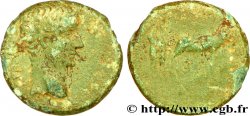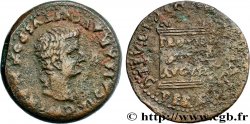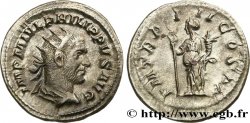v32_0129 - TIBERIO Denier
MONNAIES 32 (2007)
Начальная цена : 450.00 €
Назначить цену : 750.00 €
Цена реализации : 515.00 €
Количество ставок : 2
Максимальная предлагаемая цена : 715.00 €
Начальная цена : 450.00 €
Назначить цену : 750.00 €
Цена реализации : 515.00 €
Количество ставок : 2
Максимальная предлагаемая цена : 715.00 €
Тип Denier
Дата: c. 15-37
Монетный двор / Город: Gaule, Lyon
Металл: silver
Проба: 900 ‰
Диаметр: 19 mm
Ориентация осей монеты: 11 h.
Вес: 3,86 g.
Редкость: R1
Emission: 5e
Комментарии о состоянии
Exemplaire de qualité exceptionnelle sur un flan large et légèrement ovale. Portrait de toute beauté. Revers parfaitement centré avec le grènetis visible, de style fin où tous le détails de la draperie sont visibles. Patine de médaillier avec des reflets mordorés. A conservé une partie de son brillant de frappe et de son coupant d’origine
Ссылки в каталоге: :
C.16 (2 fr.) - RIC.26 - BMC/RE.48 - RSC.16 a - RCV.1763 (280$) - MRK.5 /4 (700€) - BN/R.34 - Giard/L1.153
Лицевая сторона
Аверс: легенда: TI CAESAR DIVI - AVG F AVGVSTVS.
Аверс: описание: Tête laurée de Tibère à droite (O*).
Аверс: перевод: “Tiberius Cæsar Divi Augusti Filius Augustus”, (Tibère César fils du divin Auguste, auguste).
Обратная сторона
Реверс: легенда: PONTIF - MAXIM.
Реверс: Описание: Pax (la Paix) ou Livie assise à droite sur un siège décoré, tenant une branche d'olivier de la main gauche et de la droite un long sceptre.
Реверс: перевод: “Pontifex Maximus”, (Grand pontife).
Комментарий
Comme pour le denier d'Auguste, cette pièce appartient à l'atelier impérial de Lyon et ce type de denier a circulé pendant pratiquement un siècle. Il se rencontre très souvent avec des monnaies gauloises de la phase terminale dans les fouilles archéologiques. C’est la monnaie romaine la plus courante en Gaule pour les Julio-Claudiens. La quatrième émission se caractérise par un socle représenté par une seule ligne et les pieds du siège sont ornés de fleurons ; les pieds de Livie reposent sur un tabouret ; au droit, les rubans de la couronne tombent en ondulations, maloidroitement, le portrait reste réaliste, mais à tendance à devenir caricatural. Ce type est normalement frappé à partir de juillet 33 d’après les conclusions de Jean-Baptiste Giard.
As with the Augustan denarius, this coin belongs to the imperial mint of Lyon and this type of denarius circulated for almost a century. It is very often found with Gallic coins from the final phase in archaeological excavations. It is the most common Roman coin in Gaul for the Julio-Claudians. The fourth issue is characterized by a base represented by a single line and the legs of the seat are decorated with fleurons; Livia's feet rest on a stool; on the obverse, the ribbons of the crown fall in undulations, clumsily, the portrait remains realistic, but tends to become caricatured. This type is normally struck from July 33 according to the findings of Jean-Baptiste Giard
As with the Augustan denarius, this coin belongs to the imperial mint of Lyon and this type of denarius circulated for almost a century. It is very often found with Gallic coins from the final phase in archaeological excavations. It is the most common Roman coin in Gaul for the Julio-Claudians. The fourth issue is characterized by a base represented by a single line and the legs of the seat are decorated with fleurons; Livia's feet rest on a stool; on the obverse, the ribbons of the crown fall in undulations, clumsily, the portrait remains realistic, but tends to become caricatured. This type is normally struck from July 33 according to the findings of Jean-Baptiste Giard








 Cообщить об ошибке
Cообщить об ошибке Распечатать страницу
Распечатать страницу Отправить мой выбор
Отправить мой выбор Задать вопрос
Задать вопрос Consign / sell
Consign / sell
 Информация
Информация















